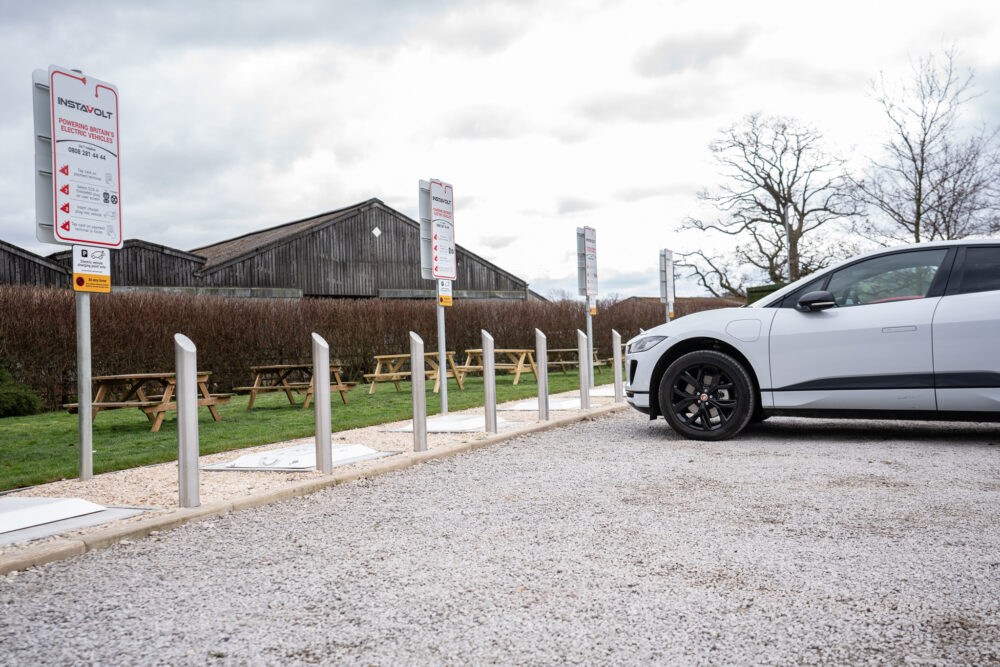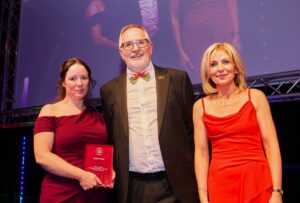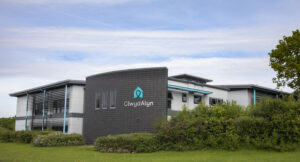Rhug Estate set to become largest private provider of Rapid Electric Vehicle Charging Points in Wales

As more and more of us are transitioning to electric vehicles, Rhug Estate has teamed up with InstaVolt to bring in the latest evolution of its service – the installation of rapid electric vehicle car charging points. Eight ultra-rapid EV charging stations, capable of adding 100 miles of range in just 15 minutes, are currently being installed in Rhug’s car park. This will make Rhug Estate the largest private provider of EV charging points in Wales!
The installation of the eight new 120kW InstaVolt chargers are in addition to the existing Dual 7kW Type 2 PodPoint chargers located at the Rhug Estate farm shop car park, which were placed five years ago, demonstrating Rhug Estate’s commitment to promptly responding to demands of the local area and its innovative ambition.
Lord Newborough, Owner of Rhug Estate said, “Scottish Power and the Welsh Government, alongside chargepoint provider, InstaVolt, have enabled us to achieve this installation in a matter of weeks and they should be up and running by the end of the Easter holidays. During periods of solar gain, the electricity supply for the new EV charging points will come directly from the solar panels located behind Rhug Estate’s farm buildings. This aspect makes it a truly green project and highly sustainable.
“Drivers and passengers will be able to enjoy the facilities at Rhug while their car is charging. Rhug Estate is perfectly situated on the A5, three miles west of Corwen, where traffic from Manchester and Chester meet the main A5 road from the Midlands before it separates again leading to the Llyn peninsular and the west Wales coast. This is an ideal place to break the journey and re-charge yourselves and the car!”
InstaVolt, the leading EV charge point supplier, was approached by Rhug Estate to provide the ultra-rapid service which it has deployed around the UK.
Adrian Keen, CEO of InstaVolt, said, “We are thrilled to be bringing reliable, rapid and accessible charging to Wales at a location of such prominence and functionality for road users. The widespread installation of EV charge points across our nation is encouraging the consumer uptake of EVs and providing them with the confidence to make those longer journeys, knowing that they have options for charging throughout the country.”
Scottish Power, the owner and operator of the electricity network in north Wales, started work in March on installing the new electricity connections at Rhug Estate which is required for the installation of the new EV charging points.
Liam O’Sullivan, Scottish Power Manweb Licence Director, said, “It’s great to see shovels in the ground in our work to enable new vehicle charging points. This additional capacity will ensure people can travel and enjoy what Wales has to offer, with access to cleaner transport.
“As well as unlocking low-carbon capacity, we hope the new infrastructure will help to drive footfall and tourism to the Rhug Estate – a valuable local business that is already a champion of high sustainability standards.
“We’re working closely with the Welsh Government to enable electric vehicle charging as we move forward with plans across many other sites. This important project will ensure the region is at the very heart of the UK’s transition to a cleaner, greener future, and that this also brings with it economic prosperity for Wales.”
Scottish Power’s work at Rhug Estate is being delivered in partnership with the Welsh Government, which will see new capacity for vehicle charging delivered at 25 sites across Wales.
A spokesperson for the Welsh Government said, “We want to ensure all electric vehicle users in Wales can confidently access charging when and where they need to. We’re very pleased to see this start to take shape at the Rhug Estate and welcome their foresight in developing rapid charging infrastructure to complement their business.”
When Lord Newborough took over the management of Rhug Estate from his father in 1998, it was his vision which shaped a wholly sustainable farming model, which included the sustainable use of natural resources. The capacity of the renewable energy schemes on the estate ranges from 4KW to 5MW and generated electricity is either used on site or exported to the grid.




